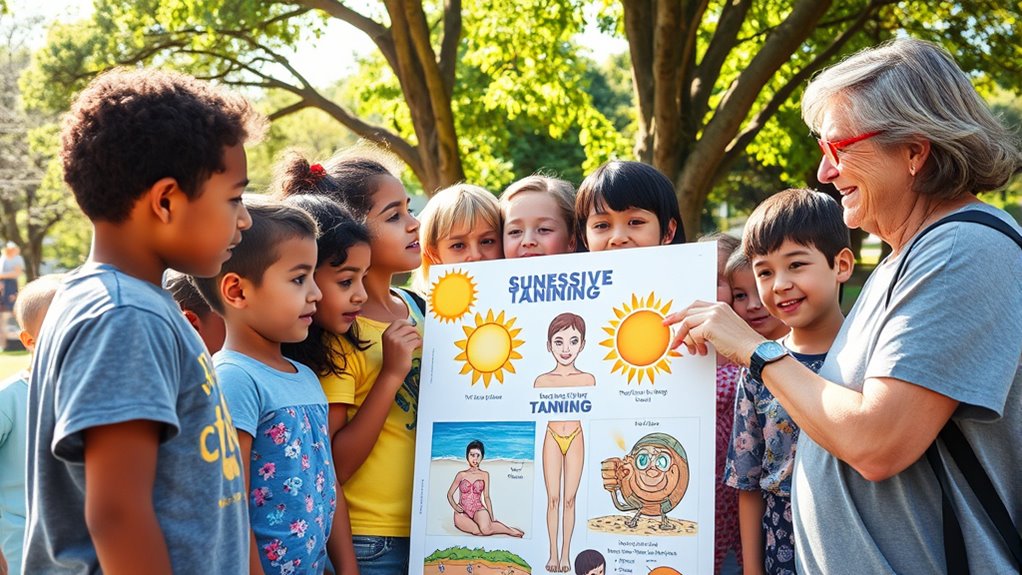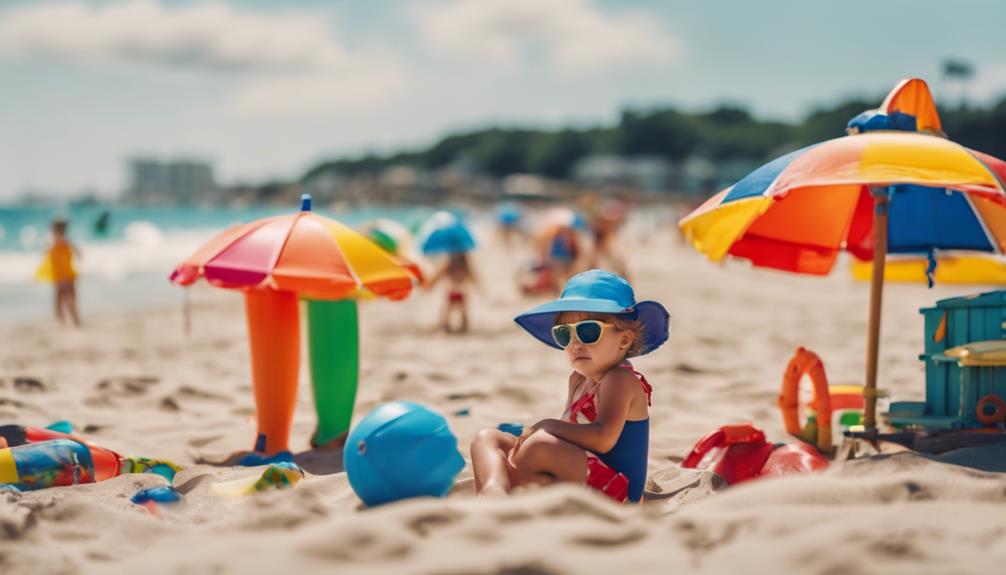Teaching children about tanning dangers helps them understand the risks of skin cancer and premature aging. Explain that a tan isn’t healthy but a sign of skin damage from UV rays. Encourage protective behaviors like wearing sunscreen, hats, and seeking shade. Be a good role model and make sun safety routine fun. Keep them informed about unsafe salon practices and the importance of avoiding tanning beds. If you want to learn how to better protect your child, keep exploring these tips.
Key Takeaways
- Explain that tanning damages skin DNA, increasing the risk of skin cancer and premature aging.
- Use age-appropriate materials to teach children that a tan is a sign of skin harm, not health.
- Encourage wearing protective clothing, broad-spectrum SPF 30+ sunscreen, and seeking shade during peak hours.
- Model sun-safe behaviors consistently and promote open family communication about UV risks.
- Keep families informed about emerging tanning trends and health risks to reinforce preventive practices.
Understanding the Health Risks of Indoor Tanning
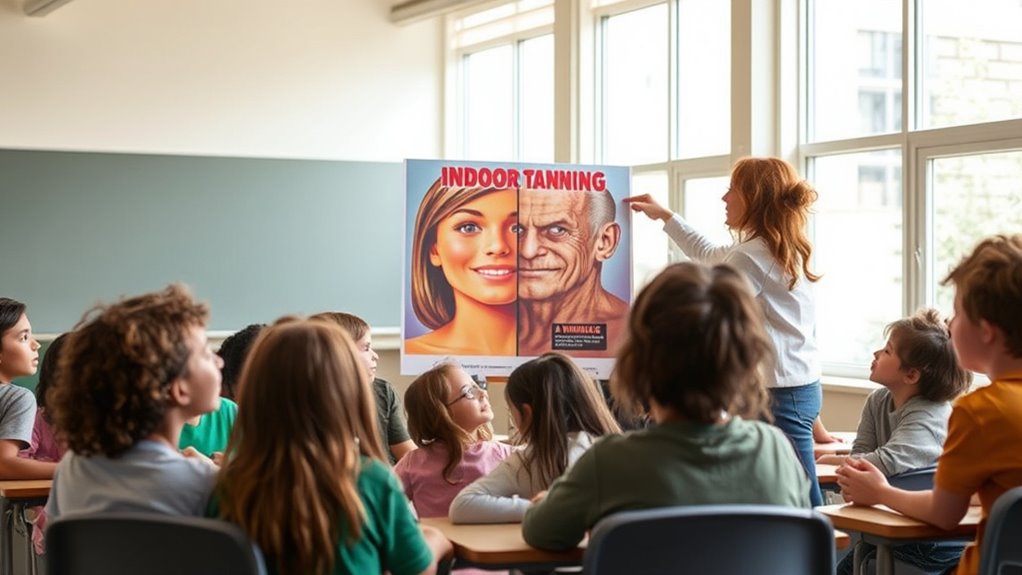
Indoor tanning poses serious health risks that you need to understand. Using tanning beds before age 18 increases your melanoma risk by 85%, and raises the chances of squamous cell carcinoma by 58% and basal cell carcinoma by 24%. The U.S. Department of Health and Human Services and WHO classify artificial UV radiation from tanning devices as carcinogenic. This exposure damages your skin’s DNA and can lead to skin cancers, premature aging, and the development of dangerous moles that may turn into melanoma. Tanning beds emit UVA and UVB rays, often at intensities equal to or greater than sunlight, which further increases your risk. Additionally, UV exposure weakens your immune system, making you more vulnerable to infections. Young women tend to tan more, which partly explains their higher melanoma rates. Recognizing the importance of financial literacy helps in understanding the long-term health costs associated with tanning. Furthermore, understanding the natural benefits of sunlight can encourage safer outdoor exposure instead of indoor tanning. Being aware of the rules governing UV exposure can help you make safer choices about sun and tanning bed use. It is also important to note that early detection of skin cancer symptoms significantly improves treatment outcomes. Research shows that Glycolic Acid is effective in improving skin health and appearance, which can be a safer alternative to tanning.
The Impact of Sunburns and UV Exposure on Children

Children are especially vulnerable to the harmful effects of UV exposure because their skin is thinner and has less melanin, which offers natural protection against the sun’s rays. When children get sunburned, they experience redness, swelling, and pain, sometimes forming blisters. Several days later, their skin may peel, itch, and dry out, lasting up to a week. Severe sunburns can cause systemic symptoms like fever, chills, headache, and nausea. Because their skin defenses are underdeveloped, even limited sun exposure during peak hours (10 a.m. to 2 p.m.) increases the risk of damage. Repeated sunburns cause cumulative skin harm, raising the chance of skin cancer later in life and accelerating premature aging. Protecting children from UV rays now reduces long-term health risks and preserves their skin health. Additionally, implementing protective measures such as wearing protective clothing and applying broad-spectrum sunscreen can significantly decrease their risk of UV-induced skin damage. Understanding sun safety practices is essential for fostering lifelong habits of skin protection, especially since UV exposure can occur even on cloudy days. Incorporating protective clothing into daily routines can provide an extra layer of defense against harmful rays.
Recognizing Unsafe Tanning Salon Practices and Regulations
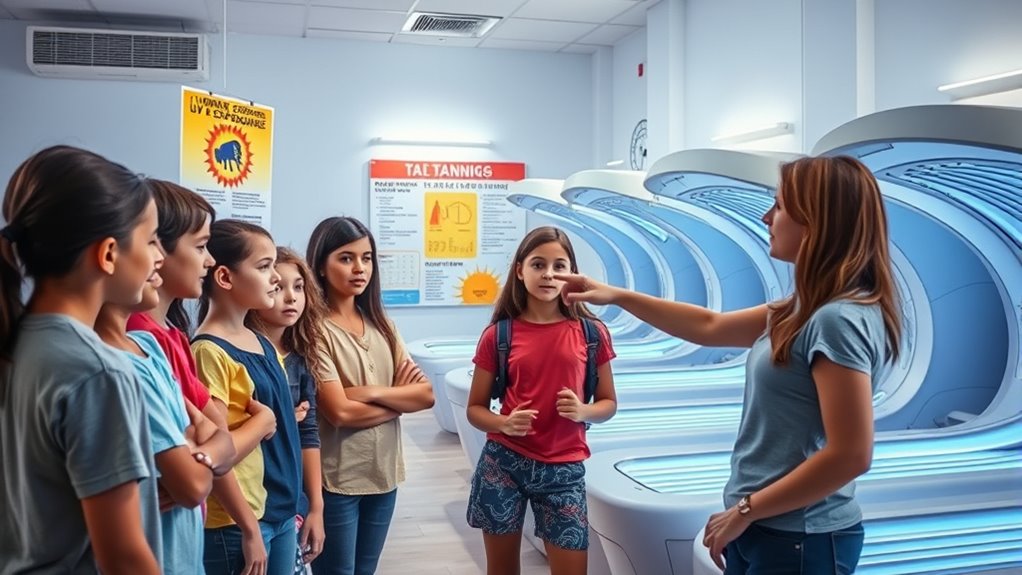
Recognizing unsafe tanning salon practices is essential for protecting young people from unnecessary health risks. Many salons ignore laws, with over 37% being noncompliant, especially in rural and southern areas. Staff often lack proper training on UV dangers and safe equipment use, increasing risk. Misinformation is common, with salons downplaying tanning’s health hazards. Some salons permit underage tanning despite legal restrictions, and equipment may not be properly maintained, exposing users to excessive UV rays. Regulations typically require warning labels, age restrictions, and licensing, but enforcement varies. Be alert for unlicensed salons or those ignoring age rules. Additionally, regulation enforcement can be inconsistent, leaving many youths vulnerable. Understanding cost variances and their implications can help advocate for stricter regulations and better compliance. By understanding these warning signs, you can help ensure children avoid unsafe practices and advocate for better regulation and enforcement in your community.
Promoting Effective Sun Safety Behaviors Among Kids

Protecting kids from the dangers of unsafe tanning practices starts with teaching them effective sun safety behaviors. Kids should understand that UV rays can cause skin damage, sunburns, and increase the risk of skin cancer later in life. Emphasize that a tan is a sign of skin harm, not health. Teach children to seek shade during peak hours between 10 a.m. and 4 p.m., and to wear broad-spectrum sunscreen with SPF 30 or higher. Encourage them to wear protective clothing, wide-brimmed hats, and UV-blocking sunglasses. Make sun safety a fun part of outdoor routines by applying sunscreen together and modeling good habits yourself. Reinforcing these behaviors early helps children develop lifelong habits that protect their skin and overall health. Developing creative practice around sun safety can make learning about healthy habits more engaging and memorable for kids. Educating children about cybersecurity vulnerabilities, such as the importance of safeguarding their personal information online, can also reinforce responsible behaviors in digital spaces. Additionally, teaching kids about the dangers of tanning helps them understand that the desire for a tan should not outweigh health considerations.
Strategies for Educating and Engaging Families in Skin Cancer Prevention
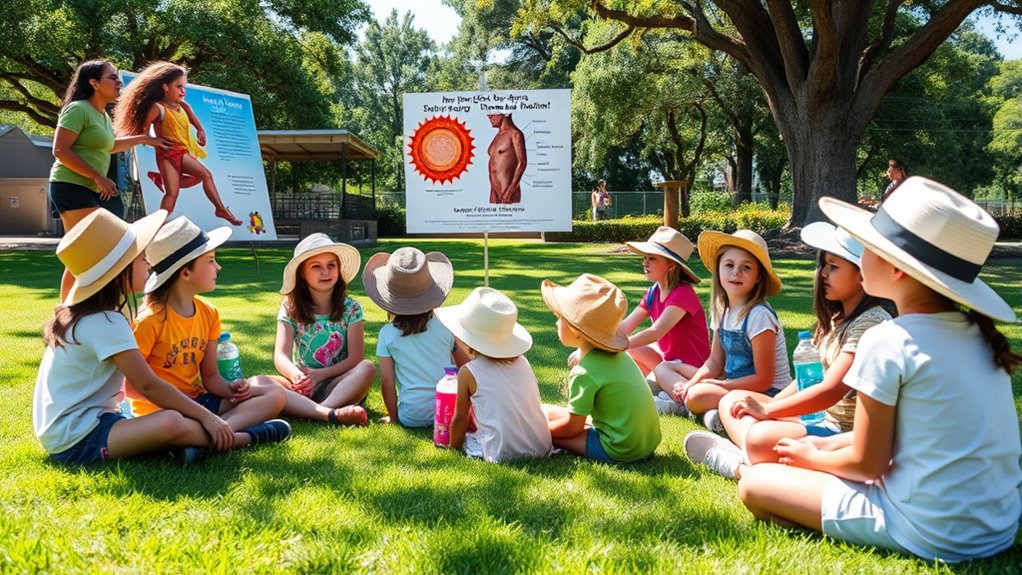
Engaging families in skin cancer prevention is essential for extending sun safety habits beyond the classroom. You can do this by sharing clear, accessible information with parents, encouraging them to reinforce protective behaviors at home. Hosting informational sessions or distributing educational materials increase understanding of skin cancer risks. Promoting parent-teacher communication helps maintain consistent messaging and support for children’s sun safety. Involving families in fun, interactive activities like making UV-protective clothing or DIY sunscreens boosts engagement. Providing checklists for skin checks and age-appropriate literature enhances vigilance. Parents modeling sun-safe behaviors, such as wearing hats and seeking shade, reinforce habits through observation. Collaborating with healthcare providers and community groups expands resources, making prevention efforts more effective and culturally sensitive. Additionally, introducing Self Watering Plant Pots as a metaphor can help children understand consistent care and responsibility in health habits. Recognizing the importance of proper maintenance can also inspire families to adopt sustainable sun protection routines that benefit both health and the environment. Furthermore, emphasizing the role of dynamic communication exercises for couples can serve as a model for fostering open dialogue and active engagement within families about health and safety practices. Moreover, conducting regular risk assessments of current sun safety strategies ensures that families remain informed about emerging threats and best practices.
Frequently Asked Questions
How Does Indoor Tanning Affect Children’s Long-Term Skin Health?
Indoor tanning can seriously harm your child’s long-term skin health. It exposes them to intense UVA rays that cause DNA damage, increasing their risk of skin cancers like melanoma later in life. Tanning accelerates premature aging, leading to wrinkles and age spots early on. Plus, it weakens their immune system, making it harder to fight off skin issues. The more they tan as kids, the greater their risk of lasting skin damage.
What Are the Signs of Unsafe Tanning Salon Practices to Look Out For?
When visiting a tanning salon, look out for unclear or missing warning signs, as many salons neglect proper signage. Check if they enforce safety measures like providing protective eyewear and limiting UV exposure time. Be wary of poorly maintained equipment that may emit excessive UV rays. If staff don’t inform you of health risks or ignore safety guidelines, those are signs of unsafe practices. Always prioritize salons that follow regulations and display clear warnings.
Are There Age Restrictions for Tanning Bed Use in Different States?
Did you know that 30 states regulate minors’ indoor tanning, with 10 banning it entirely? You’ll find laws vary: some states require parental consent or accompaniment, while others impose full bans for those under 18. If you’re in states like California or Texas, minors can’t tan at all. In contrast, states like Missouri or Virginia have specific rules for parental involvement, reflecting varying levels of protection for young skin.
How Can Schools Integrate Sun Safety Education Into Their Curricula?
You can integrate sun safety education into your school curriculum by embedding it into science, health, or safety lessons. Use interactive activities, like experiments or games, to engage students actively. Incorporate programs such as SunWise or SunAWARE to provide structured lessons. Encourage parental involvement with take-home resources. By doing this, you empower students to adopt lifelong sun protection habits, creating a safer outdoor environment and reducing their future skin cancer risk.
What Are Effective Ways for Parents to Discuss Tanning Risks With Children?
Imagine planting a seed today that can prevent future health issues. As a parent, you should start early by using simple language tailored to your child’s age. Talk openly about how tanning increases cancer risk, share real stories, and set a good example by avoiding tanning beds yourself. Reinforce safe sun habits like sunscreen and shade, and offer fun alternatives like self-tanning lotions. Consistent, honest conversations protect their skin and confidence for years to come.
Conclusion
By staying informed and proactive, you can shield your children from the hidden dangers of tanning—dangers that threaten to overshadow their bright futures. Teach them about the risks, enforce safe habits, and advocate for stronger regulations. Remember, UV damage can accumulate faster than you think, turning innocent sun exposure into a lifetime of health battles. Together, you can create a safe environment where your kids thrive without the shadow of skin cancer looming over them.
